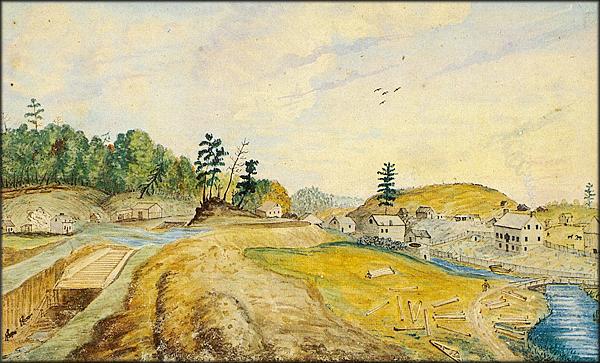|
The following is a chapter from Building the Rideau Canal: A Pictorial History - published here with permission from Parks Canada:
Brewer’s Upper Mills: Upper Lock partly built, Excavations, Embankments &c in progress; May 1830 Thomas Burrowes, watercolour, 6 ˝” x 91/2” Archives of Ontario |

| A mile below Cranberry Marsh on the Cataraqui River the water fell almost ten feet through a stretch of rapids. In 1802 John Brewer settled at this spot and by 1826 had a sawmill, brewery and grist mill in operation supporting a small settlement. Most of the buildings in the painting predate the canal and those on the upper course of the river are probably Brewer's. The circular stone structure is a lime kiln, such as were constructed at various locksites to make mortar from limestone. The other buildings are either dwellings, barns, stables or storage buildings. The works at Upper Brewers Mills backed up the river at a navigable depth through Cranberry Marsh and the Drowned Lands to Jones Falls, a distance of 11 miles. By initially planned to avoid the mill complex, but Brewer was awarded the contract for construction at the site and he afterwards agreed to sell his mill and lands. This allowed By to construct an 18-foot-high dam across the river at the site of the former milldam. A cut on the right bank carried the canal around the rapids and two locks raised the level 171/2 feet. The canal excavation can be seen on the left in the painting. The lockpits were excavated in clay with pick and shovel, and the clay removed in wheelbarrows, making use of wheeling planks. The excavated material, including rock from further up the cut, was dumped on either side of the excavation to form embankments. The major embankment, nine feet high by 176 yards long, had to be built up along the river side of the canal, and was carried in a semicircle just above the locks to form a basin. An impermeable clay puddle core wall, several feet thick, was constructed in each embankment. At the time the drawing was done, the timber sleepers of the upper lock floor had been laid on macadamized stone and the wall masonry raised several feet. The lower lockpit was still being excavated. Construction proceeded slowly as Brewer proved a meticulous craftsman and malaria was rife. In most years, anywhere from one-half to all of the 113-man work force was unable to work during the sickly season, and Brewer began to experience financial difficulties which in 1831 caused him to flee the country. His departure forced By to increase the contract price for masonry work before Robert Drummond, the Kingston Mills contractor, would agree to take over the job. The works were not completed until the spring of 1832. Like Chaffeys Mills, Upper Brewers Mills was a settlement that was actually harmed by the construction of the canal. With the mills rendered inoperable, the site was soon abandoned. Settlement revived at mid-century when William Anglin of Kingston erected a major sawmill complex, but the depletion of the forest reserves forced its closure by the 1890s. Today no evidence remains of the industrial complexes, but the former military importance of the canal is still evident at the upper end of the canal cut where a defensible lockmaster's house was erected in 1842. Otherwise, only the canal structures, a hydro-generating plant built in 1939, and a modern lock office intrude on a pastoral setting. The dam, replaced during the 19th century, is covered with grass and shrubs, as is the embankment, and both appear to be part of the natural landscape. The basin and locks remain as constructed, but the wooden floors of the locks have been capped in concrete. |